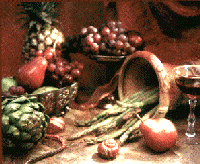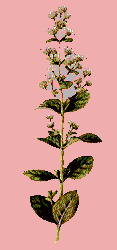
WHEN LOVE BEGAN, SO DID THE QUEST FOR APHRODISIACS.....

When love
began, so did the quest for aphrodisiacs--foods or drugs that increase
sexual desire. The very word comes from Aphrodite, the Greek goddess of
love and beauty, and suggests the divine and mysterious powers these
agents have on the body--if not the imagination. Foods were especially
popular aphrodisiacs because they were readily available and pleasurable
to consume. The very act of sharing food was romantic because it
symbolized an intimate union between two people. Today it's still romantic
for couples to share food, whether it's the symbolic first piece of
wedding cake or a sinfully rich chocolate dessert in a favorite
restaurant.

The Greeks
believed the herb marjoram was created by Aphrodite's own breath. It was
said to represent blushes, as if the goddess herself were blowing on the
cheeks of its receiver. Well into Victorian times, floral bouquets
included sprigs of marjoram to signify the love of the
sender.

For many
cultures, garlic held an inherent irony: it was proclaimed as an
aphrodisiac yet refuted for its strong aroma. The ancient maxim still
applies--if both partners eat it, who knows the
difference?
 To both the ancient
Greeks and the Elizabethans, carrots were considered aphrodisiacs. The
Greeks would refer to a carrot as a philtron, meaning love charm, and the
Elizabethans believed carrots would further the interest of Venus, giving
the eater pleasure and delight.
To both the ancient
Greeks and the Elizabethans, carrots were considered aphrodisiacs. The
Greeks would refer to a carrot as a philtron, meaning love charm, and the
Elizabethans believed carrots would further the interest of Venus, giving
the eater pleasure and delight.

Seafood is associated with
love because it comes from the sea, a major source of life. Shellfish in
particular are the strongest aphrodisiacs because of their specific
chemical makeup.

Cinnamon was once believed to increase passion and strength. It was so valued that all parts of the tropical tree were used, including its bark and seeds

History says that
Montezuma, the Aztec king, drank up to 50 cups of chocolate a day to
sustain his harem of 600 women!!!
 When love began, so did the quest for aphrodisiacs--foods or drugs that increase sexual desire. The very word comes from Aphrodite, the Greek goddess of love and beauty, and suggests the divine and mysterious powers these agents have on the body--if not the imagination. Foods were especially popular aphrodisiacs because they were readily available and pleasurable to consume. The very act of sharing food was romantic because it symbolized an intimate union between two people. Today it's still romantic for couples to share food, whether it's the symbolic first piece of wedding cake or a sinfully rich chocolate dessert in a favorite restaurant.
History says that Montezuma, the Aztec king, drank up to 50 cups of chocolate a day to sustain his harem of 600 women!!! |